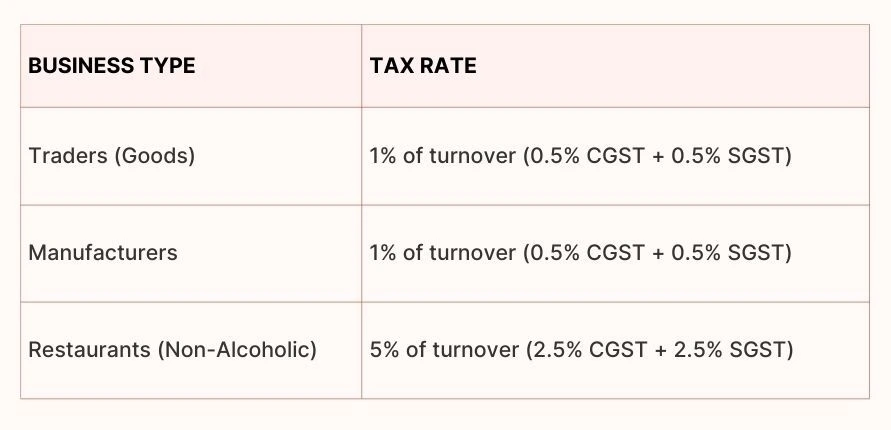Understanding the GST Composition Scheme
.webp)
When the Goods and Services Tax (GST) was introduced in India in 2017, one of its main goals was to make taxation simpler for businesses. But the government knew that small businesses might struggle with the complex filing process and high compliance burden of GST.
That’s where the Composition Scheme under GST comes in — a special, easy-to-follow option that allows small taxpayers to pay tax at a lower rate and with less paperwork.
Think of it as the "fast lane" for GST compliance: fewer returns, fewer rules, but with some conditions.
What is the Composition Scheme?
Indian small businesses can take advantage of the Composition Scheme to simplify GST taxation.
Instead of following the regular GST rules (where you pay tax at standard rates and file monthly returns), businesses under the Composition Scheme:
- The GST rate is fixed at a percentage of turnover.
- File quarterly returns instead of monthly.
- Issue a Bill of Supply instead of a tax invoice (and cannot collect tax separately from customers).
- Have less paperwork and compliance requirements.
It’s meant for traders, small manufacturers, and certain restaurants with a turnover of up to ₹1.5 crore (₹75 lakh in some states), but it comes with restrictions like no inter-state sales and no input tax credit.
Who Can Use It? Eligibility Made Easy
You qualify if your business meets these conditions:
- Turnover: All your business ventures under one PAN have an aggregate annual turnover of up to ₹1.5 crore.
- Business Type:
- Manufacturers
- Traders
- Restaurants (excluding alcohol-serving)
- Manufacturers
- Excluded:
- Interstate suppliers
- E-commerce sellers (TCS applicable)
- Casual taxable person or non-resident taxable person.
- Interstate suppliers
Why It’s Handy for Small Businesses
- Low Tax Rates: You pay a fraction of GST, based on your business type.
- Quarterly Returns: No monthly filings, just one simpler return every quarter.
- Less Paperwork: No need to maintain complex invoices or collect tax from customers.
What Are the Tax Rates?
Here's a breakdown:

These are far lower than regular GST rates (typically 5% to 18%), offering a clear advantage for small-scale operators.
What’s Not Allowed Under the Scheme
- No Input Tax Credit: ITC cannot be claimed for GST paid on your purchases.
- No Tax Invoices: Instead of a detailed tax invoice, you issue a Bill of Supply with the words “composition taxable person — not eligible to collect tax.”
- Inter-State Supply Not Allowed: You can’t send goods outside your state. That would push you out of this scheme.
Registration & Compliance Made Easy
- How to Join: Choose the scheme at the time of GST registration (in FORM GST REG-01) or by filing FORM GST CMP-02 before the financial year begins.
- Quarterly Filing: From FY 2020-21 onwards, composition taxpayers must make a quarterly tax payment using FORM GST CMP-08. This is a simple statement-cum-challan where you declare your turnover and pay the applicable tax.
Due Date: 18th of the month following the quarter.
- Say No to Monthly Returns: Unlike regular GST, there’s no monthly return burden.
CMP-08, GSTR-4 and GSTR-9A are the three key returns that fall under composition scheme compliances.
Need to Withdraw or You Cross the Limit?
- Crossed the Limit: If your turnover exceeds ₹1.5 crore (or ₹75 lakh/₹50 lakh in special states), the scheme ends automatically from that day.
- Voluntary Withdrawal: File FORM GST CMP-04 to exit.
- Claiming Credit on Stock: You can claim input tax credit on unsold inventory and capital goods when exiting—but you must file FORM GST ITC-01 within 30 days.
Important Rules to Remember
- Display Notice: Clearly display “composition taxable person” at your shop.
- Prominent Bill Note: Bills should state “composition taxable person—tax not collected.”
- Volume Threshold: As long as turnover remains below the threshold and other conditions are met, you remain in the scheme.
- Wrong Inclusion: If you shouldn’t be in the scheme (e.g., when doing interstate trade), you may face penalties under GST law.
Examples to Clarify
- Small Goods Retailer: A shop in Pune with ₹1 crore annual turnover, selling locally, can register under the scheme. Pays lower tax, files just quarterly, and uses simplified billing.
- Restaurant Owner: Runs a small restaurant without alcohol, ₹1 crore turnover—opting in means paying just 5% total GST and skipping monthly filings.
- Manufacturer Growing Big: If turnover crosses ₹1.5 crore mid-year, he must switch to the regular GST system and shift to monthly returns and input credits.
Why Small Businesses Prefer It
- Lower Tax Burden: A few percentage points, not double digits.
- Simplified Filing: Just one return every three months.
- Greater Focus: Less time on compliances means more time running the business.
Conclusion
The GST Composition Scheme is tailor-made for small businesses—keeping your tax minimal, your paperwork light, and your compliance simple. It's especially beneficial if you mainly operate within one state and are a trader, manufacturer, or restaurant (non-alcoholic). While you give up input credits and interstate sales aren’t allowed, the ease of doing business more than compensates.

.svg)








.svg)






